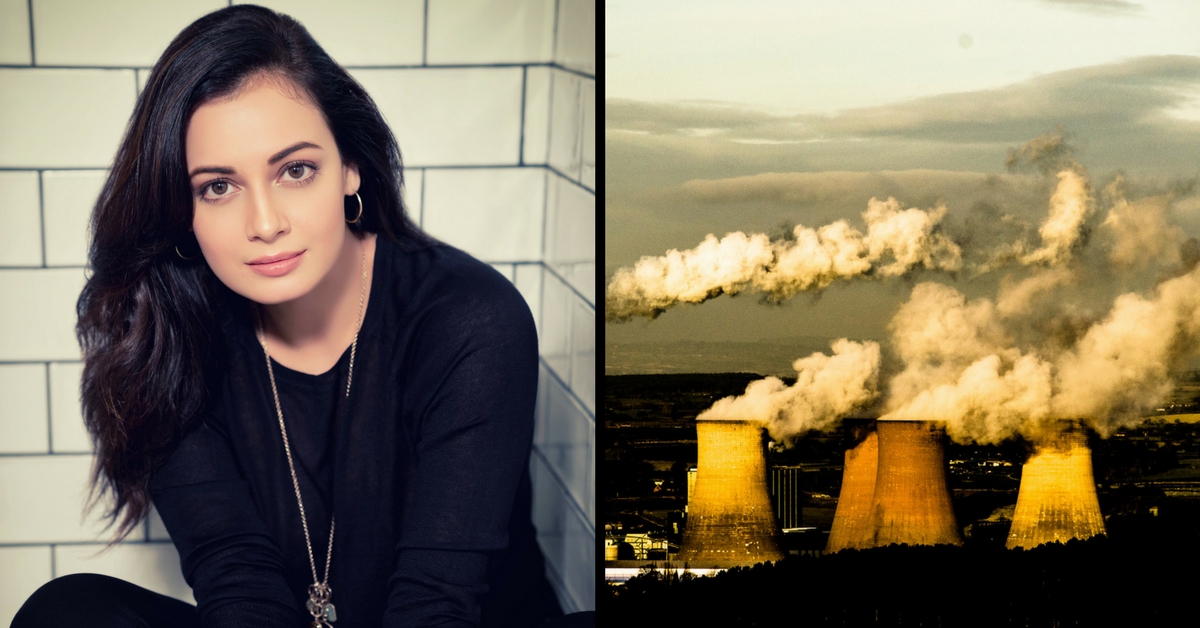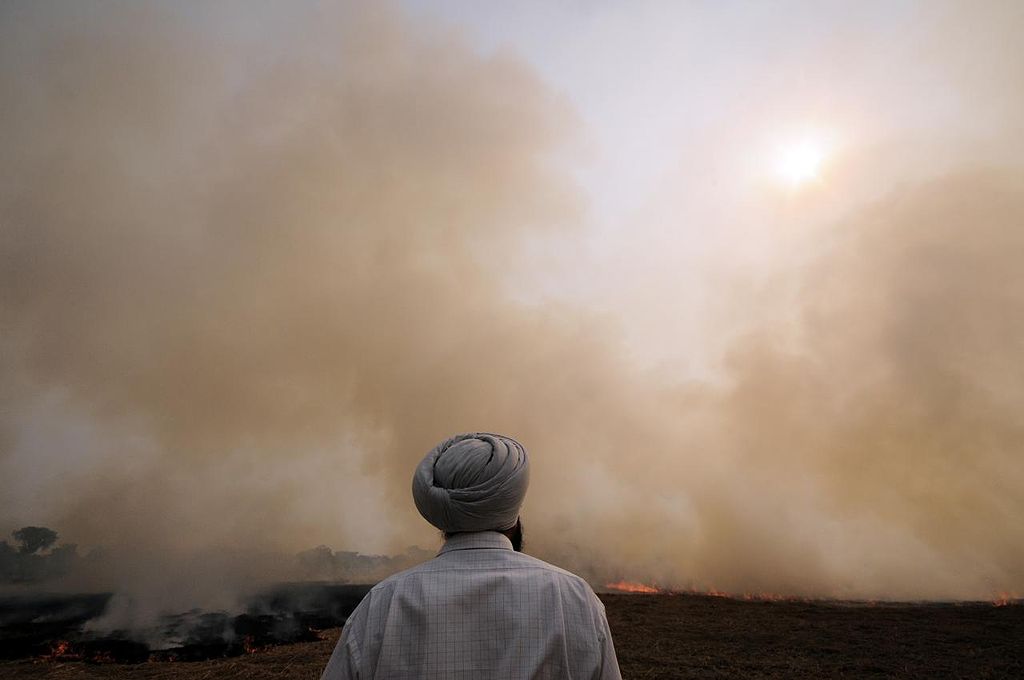Dia Mirza: “Together We Can Clean up the Planet and #BeatPollution”
As citizens we must know that the following measures can and must be implemented by our governments and imbibed by society

An infant child with big, beautiful eyes is listlessly nestled in her mother’s arms on a street pavement waiting for the next traffic signal to turn red. The air is dense with smog, a thick layer of pollution envelopes the city. The mother watches as vehicles pass her by, her eyes burning, her chest hurting, clinging to her baby unknowing of the irreversible damage the toxic air is causing to both mother and child.
There are more than 51,000 children that live in street situations in Delhi alone.
As I write this piece, the air particulate matter (PM2.5) has crossed 1000 parts per million in many parts of Delhi/NCR today.

Picture for representation only. Source: Flickr
This is 100 times beyond the recommended limit by the World Health Organization. Breaching the limit of PM2.5 of 300 is considered hazardous; imagine the impact of the air on all lives when it has breached 1000! The National Medical Association has declared this a National Health Emergency. The National President Indian Medical Association Mr.K.K.Aggarwal has circulated a video notice to the citizens of Delhi to shut schools, avoid outdoors and implement every possible measure to ensure nothing more contributes to this already hazardous air quality for the next three days. As I watch this video and read the multiple reports about the smog in Delhi, I can’t help but think of those 51,000 children.
Last year a citizens movement started by mothers in Delhi (after the Air Quality Index (AQI) breached PM2.5 to 880 post-Diwali) called #MyRightToBreathe, displayed the social will to demand change, a desperate cry from our country’s most concerned citizens. These mothers bought air purifiers and masks, and made sure they didn’t burn ‘lodi’ fires, crackers at weddings and celebrations. Many mothers contemplated resettling their children in other, safer parts of the country. Some moved bag, baggage and children, but most stayed. They fought with friends and family who remained unconvinced of the seriousness of this issue, or unmoved to improve lifestyle choices. They demonstrated the collective will to ensure the implementation of better air quality standards; they ensured they used every platform of communication to advocate awareness on the hazards of poor air quality and the measures to improve air quality.
Their movement has been strengthened by their resolve to #BeatPollution, even more so today.
“Air pollution is the single biggest environmental health risk, causing roughly 7 million deaths annually. Short-lived pollutants – which include black carbon, methane, ozone, and airborne particles produced by industrial operations and the burning of diesel, coal, kerosene or biomass – are responsible for about one-third of deaths from stroke, chronic respiratory disease and lung cancer and one-quarter of deaths from heart attack. These pollutants are also contributing to global warming, lowering labour productivity, and increasing food insecurity around the world,” states UN environment assembly’s website.
This means that air pollution is one of the biggest public health hazards today. Delhi is not the only city in India that suffers from the hazardous air; many cities, towns and villages are experiencing the fatal effects of poor air quality.
So, what are the contributors to air pollution?

Picture for representation only. Source: Wikimedia
Outdoor or ambient air pollution is caused by emissions from coal power generation, transport, poor vehicle emission standards, industrial furnaces, brick kilns, wildfires, construction dust, burning agricultural waste (crop stubble), burning of (garbage) municipal waste, dust storms and usage of solid fuels and open fires for cooking and heating. Human beings are responsible for almost all the causes of air pollution and those affected most by this are the poor but the fact is no one can escape the health impairments of hazardous ambient air.
The good news is that we can #BeatPollution! With collective will, we can ensure that the best standards to maintain air quality are established and enforced. To assume that air pollution is an unavoidable consequence of modern economic growth is misplaced. China has demonstrated that effective clean air actions can lead to 21% decrease in PM2.5 concentration in just two years! Their measures to improve air quality are working because of well-publicized moves to improve air quality and reduce pollution across the country, through stringent Air Pollution Prevention and Control Action Plan. Studies confirm the effectiveness of China’s clean air action. The world has demonstrated the technical, economic and political feasibility of pollution control.
I am no expert, yet I have access to information just as any government body or citizens do if they are earnestly willing to seek solutions. As citizens we must know that the following measures can and must be implemented by our governments and imbibed by society to ensure improvement in air quality and public health in the immediate future.
India needs to urgently:
• Establish, publicize, adhere and enforce air quality standards
• Improve and install technology to study and monitor air quality
• Stop burning waste/garbage and implement technology/manpower to ensure segregation, management and proper disposal of waste
• Stop burning of crop stubble/agricultural waste and implement sustainable solutions for management of agricultural waste
• Improve standards and norms of construction and stop construction in the months of increased risk of smog
• Have stricter vehicle emission standards and efficiency standards
• Stop burning firecrackers, be it Diwali, weddings, new year or any festivity
• Stop marathons, rally’s, outdoor events and activities on all days with poor air quality
This is doable. It will take wise leadership, partnership and strong political and personal will to implement these changes.

Picture for representation only. Source: Flickr
But if we succeed in achieving the above goals, we can and will experience a significant reduction in air pollution by next October. And by next year when the traffic light turns green, the child and mother will be safer.
Lets #BeatPollution together! Sign the #BeatPollution pledge and find out how you can reduce your pollution footprint! Your pledge will be shared with leaders gathering at the UN Environment Assembly in December 2017. Help us inspire them to make bold commitments to eliminate pollution in all its forms. Together, we can clean up the planet.
Like this story? Or have something to share? Write to us: [email protected], or connect with us on Facebook and Twitter.
NEW: Click here to get positive news on WhatsApp!
If you found our stories insightful, informative, or even just enjoyable, we invite you to consider making a voluntary payment to support the work we do at The Better India. Your contribution helps us continue producing quality content that educates, inspires, and drives positive change.
Choose one of the payment options below for your contribution-
By paying for the stories you value, you directly contribute to sustaining our efforts focused on making a difference in the world. Together, let’s ensure that impactful stories continue to be told and shared, enriching lives and communities alike.
Thank you for your support. Here are some frequently asked questions you might find helpful to know why you are contributing?


This story made me
-
97
-
121
-
89
-
167











